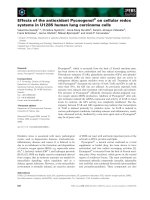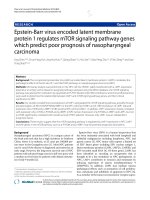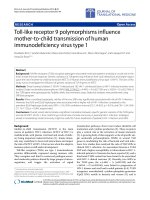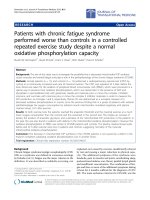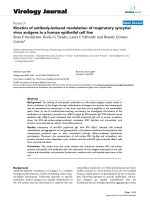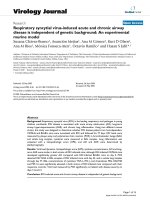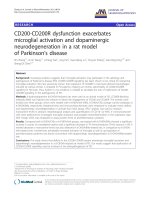Báo cáo hóa học: " Respiratory syncytial virus glycoproteins uptake occurs through clathrin-mediated endocytosis in a human epithelial cell line" docx
Bạn đang xem bản rút gọn của tài liệu. Xem và tải ngay bản đầy đủ của tài liệu tại đây (342.6 KB, 4 trang )
BioMed Central
Page 1 of 4
(page number not for citation purposes)
Virology Journal
Open Access
Short report
Respiratory syncytial virus glycoproteins uptake occurs through
clathrin-mediated endocytosis in a human epithelial cell line
Abel Gutiérrez-Ortega
1
, Carla Sánchez-Hernández
2
and Beatriz Gómez-
García*
3
Address:
1
Centro de Investigación y Asistencia en Tecnología y Diseño del Estado de Jalisco A.C., Av. Normalistas #800, Colinas de la Normal, C.P.
44270, Guadalajara, Jalisco, México,
2
Centro Universitario de Ciencias Biológicas y Agropecuarias, Universidad de Guadalajara, Carretera
Guadalajara-Nogales km 15.5, Las Agujas, C.P. 45110, Zapopan, Jalisco, México and
3
Departamento de Microbiología y Parasitología, Facultad de
Medicina, Universidad Nacional Autónoma de México, Circuito Interior, Ciudad Universitaria, DF México, México
Email: Abel Gutiérrez-Ortega - ; Carla Sánchez-Hernández - ; Beatriz Gómez-
García* -
* Corresponding author
Abstract
Cell-surface viral proteins most frequently enter the cell through clathrin or caveolae endocytosis.
Respiratory syncytial virus antigen internalization by immune cells is via caveolin, however, uptake
of paramyxovirus cell membrane proteins by non-immune cells is done through clathrin-coated
pits. In this work, the uptake of respiratory syncytial virus cell surface glycoproteins by non-immune
human epithelial cells was investigated through indirect immunofluorescence with polyclonal anti-
RSV antibody and confocal lasser-scanner microscopy. Clathrin and caveolae internalization
pathways were monitored through specific inhibitors monodansylcadaverine (MDC) and methyl-
beta-cyclodextrin (MBCD), respectively. Internalization of RSV antigens was inhibited by MDC but
not by MBCD, implying that clathrin-mediated endocytosis is the major uptake route of RSV
antigens by an epithelial human cell line.
Findings
Respiratory syncytial virus (RSV) is an enveloped, non-
segmented negative-stranded RNA virus, classified within
the Paramyxoviridae family (genus Pneumovirus). World-
wide, it is implicated in the majority of lower respiratory
tract infections in young children and it is a significant
pathogen in the elderly and immunocompromised, being
airway epithelial cells the main target for viral replication
[1]. Its genome encodes two non-structural and nine
structural proteins, three of which are transmembrane sur-
face glycoproteins, F, G and SH. The disulfide-bonded
protein F (fusion protein) and the large G protein (attach-
ment protein) are the mayor antigenic determinants of
the virus and play a crucial role in virus uptake/penetra-
tion by the host, while SH inhibits tumor necrosis factor-
alpha (TNF-a) signalling [2-5].
Internalization of envelope viral components may be an
important posttranslational regulatory mechanism that
modulates the surface expression of viral glycoproteins.
Spontaneous and anti-viral antibody-mediated endocyto-
sis of cell surface envelope glycoproteins of paramyxovi-
rus in non-immune epithelial cells is clathrin mediated
[6]; in contrast, spontaneous endocytosis of RSV antigen
in immune dendritic cells is via caveolin [7]. Previously,
we reported that RSV antibody-dependent antigen inter-
nalization in non-immune epithelial cells is partially
inhibited by incubation in hypertonic medium, suggest-
Published: 25 October 2008
Virology Journal 2008, 5:127 doi:10.1186/1743-422X-5-127
Received: 24 September 2008
Accepted: 25 October 2008
This article is available from: />© 2008 Gutiérrez-Ortega et al; licensee BioMed Central Ltd.
This is an Open Access article distributed under the terms of the Creative Commons Attribution License ( />),
which permits unrestricted use, distribution, and reproduction in any medium, provided the original work is properly cited.
Virology Journal 2008, 5:127 />Page 2 of 4
(page number not for citation purposes)
ing the participation of a clathrin-mediated mechanism
[8]. With the aim to confirm whether internalization of
RSV cell surface antigen-antibody complexes in epithelial
cells occurs through clathrin, the present study was under-
taken. The uptake of the antigen-antiviral antibody com-
plexes was blocked with specific clathrin and caveolae
inhibitors and endocytosis was monitored.
The endocytosis analysis was performed by confocal
lasser-scanner microscopy. For this purpose, HEp-2 cells
were RSV infected for 12 h. Origin of cells, virus propaga-
tion and infection procedures were previously reported
[8]. The infected cells were washed and incubated with
medium containing monodansylcadaverine (MDC) or
methyl-beta-cyclodextrin (MBCD) at a concentration of
0.2 or 10 mM, respectively, for 30 min at 37°C. Then the
cells were washed and incubated in the presence of the
inhibitors at the above concentrations with goat polyclo-
nal anti-RSV antibodies (AB 1128; Chemicon) diluted
1:50 in Hanks Balanced Salt Solution (HBSS) for 30 min
at 4°C. After the cells were twice washed with ice-cold
HBSS, they were immediately incubated at 37°C in pre-
warmed medium for 0, 30 and 60 min to allow endocyto-
sis to occur. Then, the cells were fixed and permeabilized
with ice-cold methanol-acetone (1:1) for 5 min, blocked
with 2.5% bovine serum albumin (Sigma) in phosphate
buffered saline (PBS). Internalized primary antibodies
were detected with rabbit anti-goat fluorescein-conju-
gated secondary antibody (81–1620; Zymed) diluted 1:50
in PBS with 1% serum albumin. After extensive washing
with PBS, the cells were mounted in Vectashield Propid-
ium Iodide medium (Vector) to visualize counterstained
nuclei. As control, infected cells without inhibitors were
treated as described. The results are shown in figure 1.
As illustrated in Figure 1, in the absence of endocytosis
inhibitors (DMSO treatment), RSV membrane proteins
are initially located on the surface of infected cells (0
min), but, as time advances, they are found distributed
inside the cells (30 and 60 min). A noteworthy observa-
tion is that there was no noticeable difference between 30
and 60 min incubation times. The same happened in RSV-
infected cells treated with the caveolae-uptake inhibitor
MBCD. On the contrary, when infected cells were treated
with the clathrin endocytosis inhibitor, MDC, RSV pro-
teins located to the surface at all incubation times, which
indicates that endocytosis of RSV membrane proteins
depends on the clathrin-mediated pathway. Clathrin-
mediated endocytosis occurs faster in comparison to cave-
olae-mediated or bulk uptake, which is a consequence of
membrane turnover. This explains why RSV proteins did
not require more than 30 minutes to be taken up.
Figure 1 also shows that some proportion of RSV protein
is still present at the surface of cells, even at the longest
incubation time. This observation could indicate that not
all RSV envelope glycoproteins are endocytosed. As meas-
ured by trypan blue staining, cell viability was unaffected
by MDC or MBCD at the concentrations used here (data
not shown), suggesting that endocytosis inhibition in
MDC-treated cells is not a consequence of pleiotropic
effects caused by MDC.
The role of clathrin-mediated uptake in any RSV-related
mechanism was not clear until recently. Knockdown of
genes associated with clathrin-mediated endocytosis as
well as the expression of dominant-negative mutants that
inhibit this uptake pathway blocks RSV infection, demon-
strating an important role of clathrin for RSV entry [9].
Proteins that are internalized through the clathrin-medi-
ated pathway usually bear the well characterized sorting
signal, YXXΦ, where X is any amino acid and Φ represents
any hydrophobic amino acid. This sorting signal was
identified in RSV SH glycoprotein as YFTL at its amino ter-
minus located on the cytoplasmic side of the membrane
[10], however, there is no current evidence that proves
this protein undergoes endocytosis.
In the present work, we confirm that clathrin-mediated
endocytosis of RSV envelope proteins bound to antiviral
antibodies takes place, but it remains to determine which
of the proteins suffers endocytosis. Moreover, we do not
know if this phenomenon is linked to an immune evasion
mechanism. To this respect, there is a report that corre-
lates internalization of plasma membrane-bound viral
glycoproteins proteins to interference with an immune
process known as antibody-dependent complement-
mediated cell lysis in pseudorabies virus-infected mono-
cytes [11]. The possible biological importance of our find-
ing requires further investigation.
Competing interests
The authors declare that they have no competing interests.
Authors' contributions
AGO participated in experimental design, carried out the
endocytosis assay and drafted the manuscript. CSH car-
ried out concentration, purification and titration of virus.
BGG conceived of the study and helped to draft the man-
uscript. All authors read and approved the final manu-
script.
Virology Journal 2008, 5:127 />Page 3 of 4
(page number not for citation purposes)
Endocytosis of RSV envelope proteins in Hep-2 cellsFigure 1
Endocytosis of RSV envelope proteins in Hep-2 cells. Hep-2 cells were infected with RSV at a multiplicity of infection of
2. After 12 h, the cells were incubated with anti-RSV goat antibody at 4°C, rinsed and subsequently incubated at 37°C at differ-
ent times (0, 30 and 60 min) to allow endocytosis to occur. The assay was performed in the presence of diluting agent dimethyl
sulfoxide (DMSO), methyl-beta-cyclodextrin (MBCD) or monodansylcadaverine (MDC). The cells were fixed/permeabilized
with ice-cold methanol:acetone and incubated with anti-goat IgG-FITC antibody. Later, unbound antibody was washed away
and the cells were finally mounted in VectaShield Propidium Iodide medium and analysed on an Olympus FV1000 confocal
microscope. RSV antigens and nuclei appear in green and red, respectively.
DMSO MBCD MDC
60 min 30 min 0 min
Publish with BioMed Central and every
scientist can read your work free of charge
"BioMed Central will be the most significant development for
disseminating the results of biomedical research in our lifetime."
Sir Paul Nurse, Cancer Research UK
Your research papers will be:
available free of charge to the entire biomedical community
peer reviewed and published immediately upon acceptance
cited in PubMed and archived on PubMed Central
yours — you keep the copyright
Submit your manuscript here:
/>BioMedcentral
Virology Journal 2008, 5:127 />Page 4 of 4
(page number not for citation purposes)
Acknowledgements
We thank Microscopy Laboratory of Instituto de Fisiología Celular, UNAM,
for the kind assistance in confocal microscopy.
References
1. Collins PL, Chanock RM, Murphy BR: Respiratory syncytial virus.
In Fields Virology 4th edition. Edited by: Knipe D, Howley P. Philadel-
phia: Lippincott Williams & Wilkins; 2001:1443-1485.
2. Karron RA, Buonaugurio DA, Georgiu AF, Whitehead SS, Adamus JE,
Clements-Mann ML, Harris DO, Randolph VB, Udem SA, Murphy BR,
Sidhu MS: Respiratory syncytial virus (RSV) SH and G proteins
are not essential for viral replication in vitro: clinical evalua-
tion and molecular characterization of a cold-passaged,
attenuated RSV subgroup B mutant. Proc Natl Acad Sci USA
1997, 94:13961-13966.
3. Techaarpornkul S, Barreto N, Peeples ME: Functional analysis of
recombinant respiratory syncytial virus deletion mutants
lacking the small hydrophobic and/or attachment glycopro-
tein gene. J Virol 2001, 75:6825-6834.
4. Teng MN, Collins PL: Identification of the respiratory syncytial
virus proteins required for formation and passage of helper-
dependent infectious particles. J Virol 1998, 72(7):5707-5716.
5. Fuentes S, Tran KC, Luthra P, Teng MN, He B: Function of the res-
piratory syncytial virus small hydrophobic protein. J Virol
2007, 81:8361-8366.
6. Vogt C, Eickmann M, Diederich S, Moll M, Maisner A: Endocytosis
of the Nipah virus glycoproteins. J Virol 2005, 79:3865-3872.
7. Werling D, Hope JC, Chaplin P, Collins RA, Taylor G, Howard CJ:
Involvement of caveolae in the uptake of respiratory syncy-
tial virus antigen by dendritic cells. J Leukoc Biol 1999, 66:50-58.
8. Sarmiento RE, Tirado RG, Valverde LE, Gómez-García B: Kinetics of
antibody-induced modulation of respiratory syncytial virus
antigens in a human epithelial cell line. Virol J 2007, 4:68.
9. Kolokoltsov AA, Deniger D, Fleming EH, Roberts NJ Jr, Karpilow JM,
Davey RA: Small interfering RNA profiling reveals key role of
clathrin-mediated endocytosis and early endosome forma-
tion for infection by respiratory syncytial virus. J Virol 2007,
81:7786-7800.
10. Rixon HWM, Brown G, Murray JT, Sugrue RJ: The respiratory syn-
cytial virus small hydrophobic protein is phosphorylated via
a mitogen-activated protein kinase p38-dependent tyrosine
kinase activity during virus infection.
J Gen Virol 2005,
86:375-384.
11. Walle GR Van de, Favoreel HW, Nauwynck HJ, Pensaert MB: Anti-
body-induced internalization of viral glycoproteins and gE-gI
Fc receptor activity protects pseudorabies virus-infected
monocytes from efficient complement-mediated lysis. J Gen
Virol 2003, 84:939-948.

